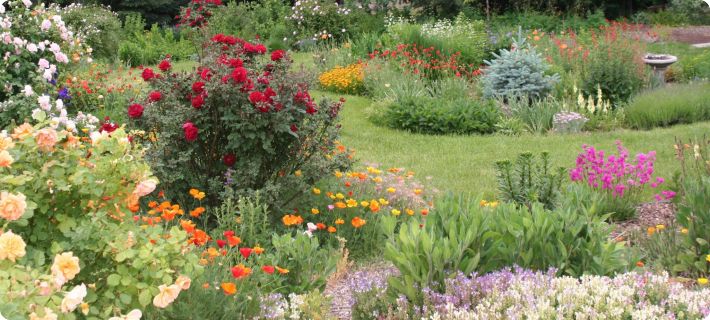Cottage Garden Design
by Diane Linsley
How do you design a cottage garden for year-round interest? Maybe even more puzzling is this question: How do you create a cottage garden from seed? This was my goal when I started gardening many years ago on a low budget.
If you enjoy watching gardening shows and reading books on garden design, but you doubt that your own garden will ever look like that, welcome to the club.
Garden design concepts are easy to understand on the intellectual level, but they often escape me in practice. Maybe these concepts simply work better in formal gardens that include lots of hardscaping and well-behaved plants like evergreens and groundcovers that don't change much with the seasons. In my semi-wild, cottage garden, things change every day. Under these circumstances, it's hard to maintain law and order.
So I've taken a different approach to garden design. I think of the cottage garden as a stage where a year-long play is being performed. My goal is to keep the interest of the audience throughout the year. I also want to have dramatic changes from month to month because I get bored easily. So I choose a different star for each month. The star needs to stand out clearly, while the rest of the plants provide the supporting cast. Here's how my play goes.
Cottage Gardening Design Ideas
March: crocuses and rock garden iris
May: tulips (early May), peonies & bearded iris (late May)
July: lilies & daylilies
August: late summer-blooming annuals
September: ornamental grasses with companion plants
October: colorful fall leaves
November - February: trees (evergreen and bare deciduous trees)
Now, you might be wondering, where are the perennials and early-blooming annuals? Well, they are the supporting cast. These plants are just as important as the stars because they help the stars shine. They come and go quickly, and they don't carry much weight individually. But they are very impressive when massed, which is a good reason to grow self-sowing annuals.
Have you ever noticed how each perennial in the garden has a slightly different bloom time? As I take my daily stroll around the garden, I see new perennials coming into bloom as others go out of bloom. The average bloom time for a perennial is 3 weeks. A garden designed around perennials can be nice. But for me, it seems to lack structure (or maybe I just never learned how to do it right). It's easier to think of perennials as companion plants for my stars.
Of course, a favorite perennial might be featured as a star in the cottage garden. I do this with lilies and daylilies. Each daylily plant only blooms for about 3 weeks. But as a group, daylilies have a long bloom season of more than 6 weeks. There are early, midseason and late-blooming varieties.
Early-blooming annuals also belong in the category of supporting cast. They go to seed quickly and need to be pulled out to make room for the late-blooming annuals, perennials and ornamental grasses. In some spots in my cottage garden, poppies are massed by the hundreds as companion plants for roses. This impresses garden visitors, who probably think that poppies are the stars in June. But in my mind, the roses are the stars because they appear throughout the garden, featured with different companion plants in each area.
You might have a different list of stars than I do. Maybe you don't want to grow roses. So design your June garden around a different plant. There are plenty to choose from. It helps to keep a notebook in which you record what blooms in your garden during each month of the year. This will become a valuable tool as you plan your cottage garden, especially in the winter time when it's hard to remember what bloomed on the fifteenth of June the previous year.
The cottage garden is always changing. Each day is a new scene in the play. I'm sure that my garden will never be featured on a television show or in a magazine. It's too wild looking. But there is a certain order to it - an order that only I can see - a grand design that keeps it all organized in my mind.
This informal way of planting gives the cottage garden a natural look, especially when the annuals self sow to fill in the cracks. If this way of gardening appeals to you, see the articles below for more cottage garden design ideas.
What is the supporting cast in winter? It's the dead foliage of the annuals, perennials and ornamental grasses that I leave standing like a giant, dried flower arrangement. Colorful berries on trees and shrubs, pine cones on evergreens, and seedheads on flowers and grasses all contribute to the drama.
This scene may look terribly messy to some people, but it's beautiful to me. It is low maintenance, and it's also the best wildlife attraction you can imagine. As I'm writing this article in late February, the pheasants are in the garden, eating seeds off the plants that I haven't yet cut down. By the time I finish my spring cleanup, the crocuses will be blooming, and the play will start all over again.
Related Articles
Companion Plants for Roses - Annuals and perennials for the rose garden.
Companion Plants for Daffodils - Early-blooming flowers and bulb covers.
Companion Plants for Ornamental Grasses - Flowers to add some color.
Self-Sowing Annuals - Flowers that reseed and come back every year.
Recommended Books
Tasha Tudor's Garden by Tova Martin & Richard W. Brown
The Bold and Brilliant Garden by Sarah Raven
Seeds
